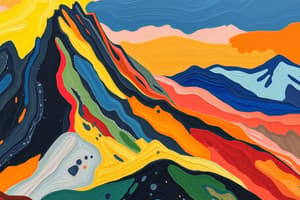Podcast
Questions and Answers
What are ores?
What are ores?
Ores are raw materials for making metals, consisting of valuable minerals combined with other elements.
Which of the following are considered major types of ore genesis?
Which of the following are considered major types of ore genesis?
- Internal processes (correct)
- Atmospheric processes
- Surficial processes (correct)
- Hydrothermal processes (correct)
Ore is a renewable resource.
Ore is a renewable resource.
False (B)
What is metallurgy?
What is metallurgy?
Which mineral is formed by the cooling down of molten materials?
Which mineral is formed by the cooling down of molten materials?
Many meteorites contain large amounts of ______.
Many meteorites contain large amounts of ______.
Match the minerals with their classifications:
Match the minerals with their classifications:
What is gangue?
What is gangue?
What are ores?
What are ores?
What is the process by which a deposit of ore is created?
What is the process by which a deposit of ore is created?
Which of the following are types of ore genesis?
Which of the following are types of ore genesis?
Ores are a renewable resource.
Ores are a renewable resource.
What is gangue?
What is gangue?
What steps are involved in extracting metals from ores?
What steps are involved in extracting metals from ores?
Which of the following is a primary mineral?
Which of the following is a primary mineral?
What are fossil fuels?
What are fossil fuels?
What is metallurgy?
What is metallurgy?
Flashcards are hidden until you start studying
Study Notes
Ores
- Ores are compounds of metals combined with other elements.
- Ores are raw materials used to make metals.
- Important ores include copper, gold, and iron.
- Ore genesis is the process of ore formation, which takes millions of years.
- Three main types of ore genesis: internal processes, hydrothermal processes, and surficial processes.
- Internal processes involve volcanic activity bringing ore from deep within the Earth to the surface.
- Hydrothermal processes involve seawater circulating through cracks in the Earth's crust, depositing minerals near hydrothermal vents.
- Surficial processes involve surface processes like erosion.
- Meteorites, pieces of rock from space, can also contain large amounts of iron ore.
- Ore is a nonrenewable resource.
- Mining is the extraction of ores buried deep underground.
- Ores are composed of the desired metal compound, impurities, and gangue (earthly substances).
Metals from Ores
- Extracting metals involves three main steps: concentrating the ore, isolating the metal, and purifying the metal.
- Metallurgy is the field of science that focuses on extracting metals from ores.
Minerals
- Minerals are naturally occurring, homogeneous solids with a definite chemical composition and ordered atomic arrangement.
- Minerals are classified as crystalline solids due to their ordered internal structure.
- Minerals are broadly classified into primary and secondary minerals.
- Primary minerals form from the cooling of molten materials (magma).
- Secondary minerals form through weathering processes at the Earth's surface.
Fossil Fuels
- Fossil fuels are hydrocarbon-containing materials formed naturally from organic matter over millions of years.
- Examples of fossil fuels include coal, oil, and natural gas.
Ores and Minerals
- Most metals are too reactive to exist naturally in the ground.
- Instead, they exist combined with other elements as compounds called ores.
- Ores are raw materials that are mined to make metals.
- Example of ores: Bauxite (Al), Chalcocite (Cu), Chalcopyrite (Cu), Chromite (Cr), Galena (Pb), Hematite (Fe), Iron Pyrite (Fe), Laterite (Al & Fe), Magnetite (Fe), Psilomelane (Mn), Pyrolusite (Mn), Sphalerite (Zn) & Stibnite (Pb)
- Minerals are individual crystals composed of unit cells or basic unit layers of at least two elements.
- There are three main ways to classify mineral formation:
- Internal processes: Volcanic activity brings ore from deep within the Earth's crust to the surface.
- Hydrothermal processes: Mineral deposits form near hydrothermal vents when seawater circulates through cracks in the Earth's crust.
- Surficial processes: Erosion and other surface-level processes can create ore deposits.
- Ore is a non-renewable resource with a finite supply.
- Mining is the process of extracting metal ores that are buried deep underground.
- Ore differs from finished metals because it contains impurities and earthly substances called gangue.
- Metallurgy is the study of extracting and isolating metals from ores found in nature.
- Most elements, especially metals, are found combined with other elements as minerals.
- Minerals are naturally occurring homogeneous solid compounds with a specific chemical composition and ordered atomic arrangement.
- Minerals are classified as crystalline solids due to their ordered internal atomic structure.
- Minerals are broadly categorized into two classes:
- Primary Minerals: These form from the cooling of molten materials (magma) in igneous processes. Examples include K-feldspars, micas, and clay-size micas found in most soils.
- Secondary Minerals: These are byproducts of weathering at the Earth's surface. Examples include Kaolinite, Chlorite, Sericite, and Serpentine.
Studying That Suits You
Use AI to generate personalized quizzes and flashcards to suit your learning preferences.




